
Lean Tarot in Agile: How to Boost Your Retrospectives

Retrospectives are at the heart of Agile practices because they guarantee the opportunity to reflect, improve, and strengthen their processes for continuous growth. However, keeping retrospectives engaging and constructive can be challenging, especially for teams working together for a long time.
Introducing Lean Tarot, a new innovative tool by Team O'Clock that brings a fresh and interactive approach to retrospectives.
The Lean Tarot cards leverage personas to identify positive and negative team behaviors, helping teams constructively address challenges. Adding a fun, structured element to retrospectives promotes open communication, collaborative discussions, and actionable insights.
Keep reading to discover how Lean Tarot works, its benefits for Agile teams, and practical tips for enhancing your retrospectives.
How Lean Tarot Fits into Agile Retrospectives
How It Works
Lean Tarot is a simple yet impactful addition to your retrospective toolkit. Each team member clicks to deal cards that may reveal red flags or positive behaviors. They can also click on the different personas to identify the green and red flags of the different roles.
The Persona cards include roles such as "The Leader," "The Fresh Manager,” or " Know-it-all.” These personas reflect different behaviors and attitudes that influence team dynamics.
The team then discusses the behaviors represented by the card descriptions, how they manifest during sprints, and their impact on the team. For example, if someone identifies with "The Product Pillar," the discussion could revolve around whether the team’s focus aligns with product goals.
This framework adds a touch of gamification to retrospectives, making them more engaging while encouraging constructive and essential conversations.
How Lean Tarot BenefitsYour Agile Team
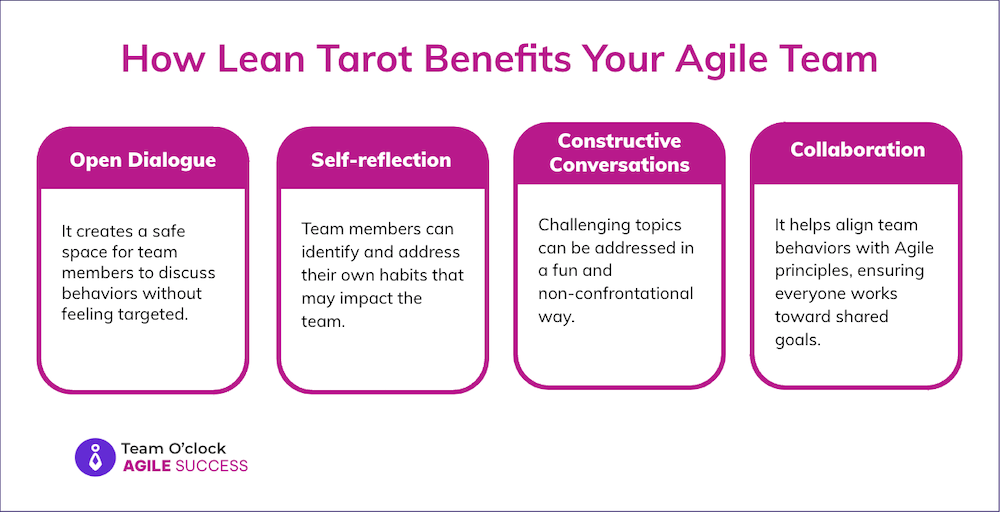
What is Your Lean Tarot Persona?
Lean Tarot features 18 personas, individuals or teams, representing common team behaviors. Here’s a closer look at five of them you might identify in your team, their role in retrospectives, and considerations for maintaining balance.
1. The Leader
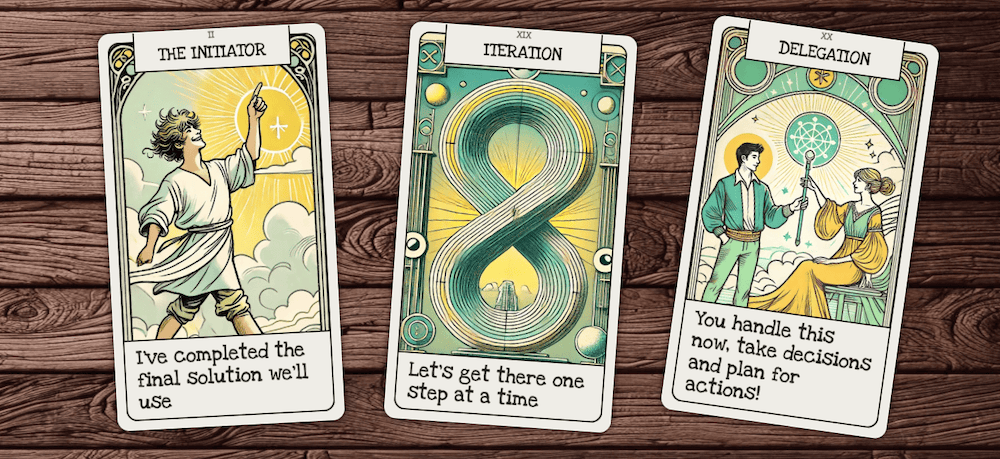
Traits: Takes initiative, values iterations, and encourages team participation.
Role in retrospectives: Guides discussions on aligning team efforts with Agile values, often acting as the voice of reason.
Caution: Leaders may unintentionally dominate discussions or rush the team towards solutions. Encourage them to step back and create space for others to contribute.
2. The Product Pillar
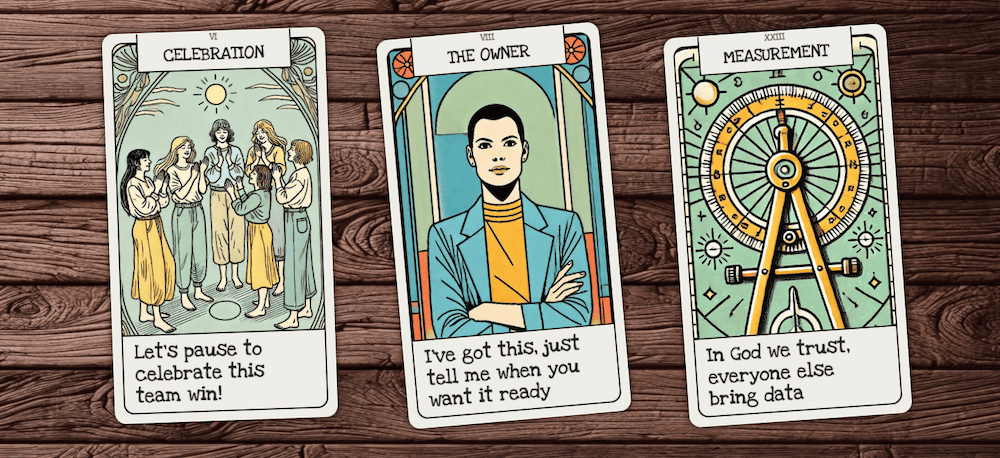
Traits: Takes full ownership of tasks and is focused on the product’s direction, team bonding, and celebrating successes.
Role in retrospectives: Evaluates whether the team’s progress aligns with product goals and celebrates milestones.
Caution: The Product Pillar may allow celebrations to hinder momentum or not align them with meaningful milestones. It’s essential to acknowledge everyone’s efforts while staying on course.
3. The Fresh Manager
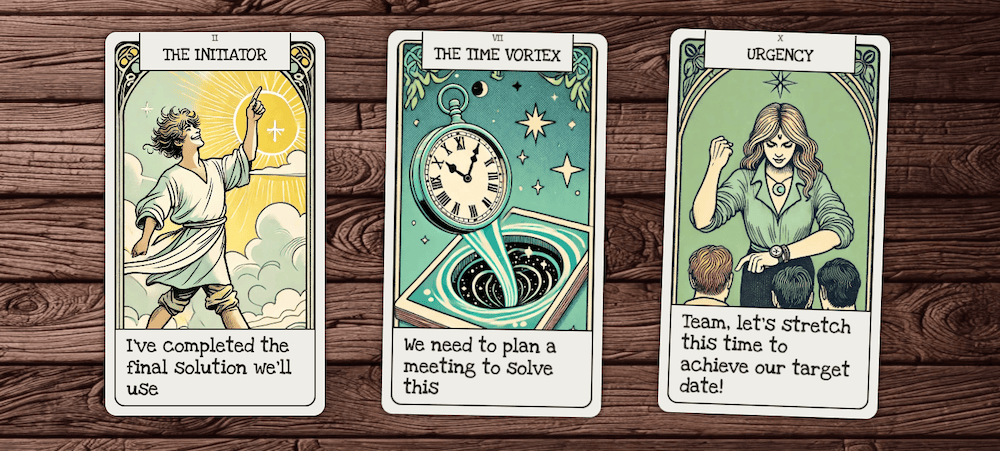
Traits: Enthusiastic, eager to try new approaches, and keen to be helpful.
Role in retrospectives: They bring fresh ideas and suggest innovative solutions for team processes.
Caution: Their enthusiasm may lead to unnecessary meetings or tasks that derail focus. Encourage them to prioritize before acting and not lose sight of the team’s long-term goals.
4. The Know-it-All
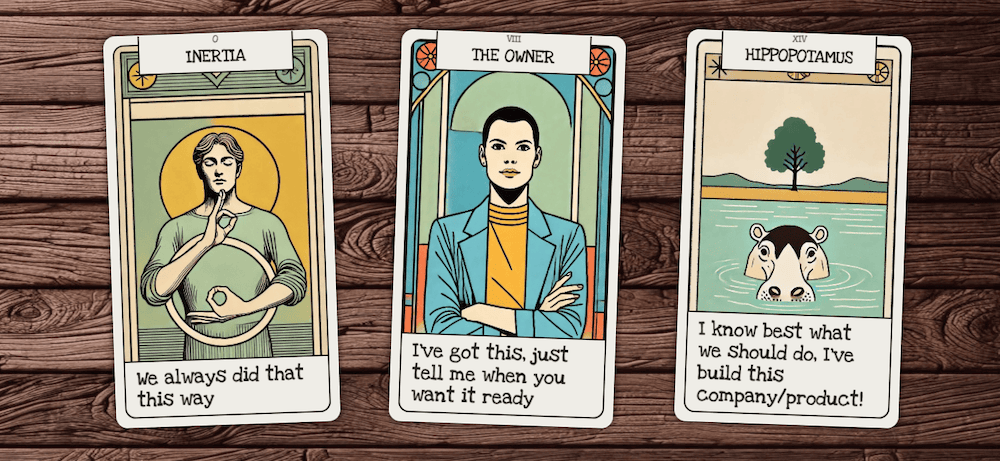
Traits: Experienced, confident, and provides reliable delivery.
Role in retrospectives: They share valuable expertise and insights, helping the team build on proven practices.
Caution: As creatures of habit, they tend to reject new ideas before evaluating them. They must be reminded that as conditions change, they must evolve and keep up with the latest needs.
5. The Linear Team
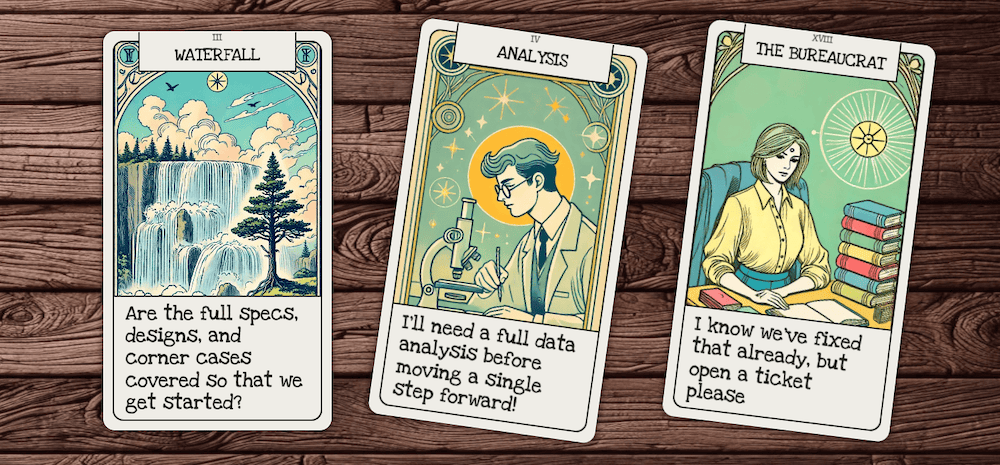
Traits: Prefers traditional Waterfall approaches, focusing on extensive planning.
Role in retrospectives: They provide thorough feedback and highlight risks.
Caution: This persona may struggle with Agile’s iterative nature. Educate them on how Agile adaptability and flexibility drive success.
How to Use Lean Tarot in Your Retrospectives
Setting the Stage
Prepare the deck: Ensure each card features a persona with a description and key behaviors.
Introduce Lean Tarot: Explain the purpose of the personas and how they help identify team behaviors constructively.
Draw cards: Each team member draws a set of three cards or clicks on a Persona card and reflects on how the green or red flags in the card descriptions relate to their behavior during the sprint.
Discuss insights: Facilitate a team discussion on how the different traits influenced the sprint.
For Example:
Imagine a retrospective with a six-person Agile team:
Step 1: Team members draw cards.
Step 2: One member draws "The Know-it-All" and admits they resisted trying a new tool. The team discusses how this affected their workflow and brainstorms ways to embrace new ideas.
Step 3: Another member identifies as "The Leader" and highlights areas where team alignment improved Agile practices.
Encouraging Feedback
After the retrospective, ask team members to share their thoughts on Lean Tarot.
Did it spark meaningful conversations?
Were the personas helpful in identifying behaviors?
Use this feedback to refine future sessions and allow transparent and constructive conversations.
3 Practical Tips for Running a Lean Tarot Retrospective
Encourage Open Participation
Remind team members that Lean Tarot isn’t about labeling or blaming but understanding behaviors to improve team dynamics.
Create a psychologically safe environment where everyone feels comfortable sharing.
Avoid Common Pitfalls
Dominating discussions: Gently guide dominant personas, like "The Leader," to allow quieter team members to contribute.
Downplaying others’ feedback: Ensure all insights, even those from "The Fresh Manager" or "The Linear Team," are valued.
Keep It Constructive
Focus on solutions, not problems. For example, if "The Know-it-All" resisted change, discuss how the team can approach similar scenarios more effectively.
Emphasize collaboration, reminding the team that retrospectives aim to drive continuous improvement.
Takeaway
Lean Tarot by Team O'Clock is a game-changer for Agile retrospectives. Introducing relatable personas encourages self-reflection, open communication, and actionable insights. Teams can identify behaviors constructively, address challenges collaboratively, and strengthen their alignment with Agile principles.
If your retrospectives have become routine or stagnant, Lean Tarot can transform them into meetings everyone looks forward to, making them more engaging and impactful.
Ready to boost your team’s morale and productivity in the next Agile meeting? Try Lean Tarot with your team today and experience the difference for yourself! Explore more Agile solutions on Team O’Clock and take the first step toward continuous improvement.








